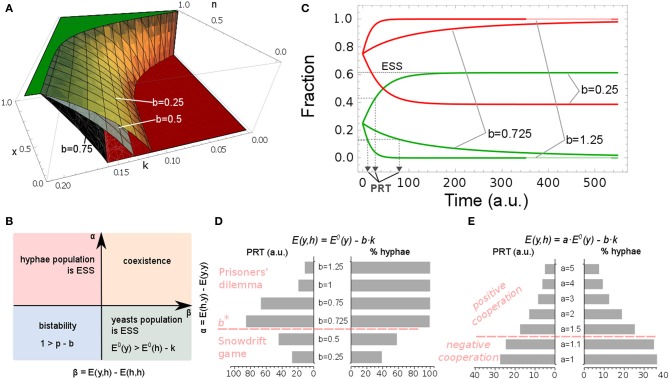Figure 4.
Effect of immune system on a population profile. Yeast fraction is given by x. (A) Population profiles for different n and k. Green plane represents pure yeast population, x = 1, and red plane refers to the population consisting solely of hyphal cells, x = 0. The switch to pure hyphae population is influenced by the values of b. Yellow surface for b = 0.25; gray surface for b = 0.5; black surface for b = 0.75. (B) Stability analysis of the steady states. Parameter space is divided into α and β (see Figure labels). The pure yeast or pure hyphal populations are possible evolutionary stable steady states (ESS) but coexistence of the two forms may also arise; in these cases, it is independent of the initial yeast/hyphae ratio. By altering PMNs' attraction toward yeast and hyphae forms (d and b), bi-stability in the system may occur and the final steady state is dependent on the initial fractions. (C) Simulation of model A. Parameters are set to the values given in Table 2. Population profile dynamics for different values of parameter b in the yeast payoff E(y, h) = E0(y)–b · k. For low host activity, b = 0.25, yeast cells are initially favored, as they increase in frequency (green line) and both cell types will coexist, as hyphal cells persist in the system (red line). Population response time, PRT, indicates the time needed for yeast cells to reach 50% of the final steady state fraction. (D) The immune system strength, b · k, influences the hyphal fraction and PRT. By increasing the yeast's cost, by setting the value of b to one indicated in the figure, the PRT initially increases, but after reaching a certain threshold, b*, the PRT decreases dramatically. The game dynamic interactions switch from Snowdrift game dynamics to Prisoners' dilemma game dynamics. (E) Variations in yeast maximal payoff, E0(y), influence the hyphae fraction and PRT. A scalar a has been introduced in E(y, h) = a · E0(y) − b · k. By setting the value of a to one, as indicated in the figure, yeast payoff is increased and PRT decreases whilst the fraction of hyphae in the population drops. At the same time, fungal interaction types change from negative cooperation to positive cooperation.

